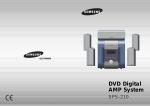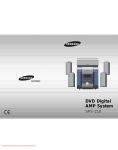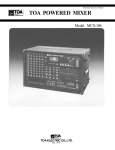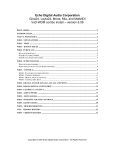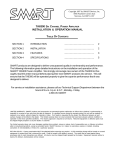Download Black Box Local Mux-6 Specifications
Transcript
MARCH 1997 MX895A MX895AE Local Fiber Mux-6 -6 l Mux Loca LLB SYNC AL LOC RLB LOSS OTE REM TEST ER POW CUSTOMER SUPPORT INFORMATION Order toll-free in the U.S.: Call 877-877-BBOX (outside U.S. call 724-746-5500) FREE technical support 24 hours a day, 7 days a week: Call 724-746-5500 or fax 724-746-0746 Mailing address: Black Box Corporation, 1000 Park Drive, Lawrence, PA 15055-1018 Web site: www.blackbox.com • E-mail: [email protected] LOCAL FIBER MUX-6 FEDERAL COMMUNICATIONS COMMISSION AND INDUSTRY CANADA RADIO FREQUENCY INTERFERENCE STATEMENTS This equipment generates, uses, and can radiate radio-frequency energy, and if not installed and used properly, that is, in strict accordance with the manufacturer’s instructions, may cause interference to radio communication. It has been tested and found to comply with the limits for a Class A computing device in accordance with the specifications in Subpart B of Part 15 of FCC rules, which are designed to provide reasonable protection against such interference when the equipment is operated in a commercial environment. Operation of this equipment in a residential area is likely to cause interference, in which case the user at his own expense will be required to take whatever measures may be necessary to correct the interference. Changes or modifications not expressly approved by the party responsible for compliance could void the user’s authority to operate the equipment. This digital apparatus does not exceed the Class A limits for radio noise emission from digital apparatus set out in the Radio Interference Regulation of Industry Canada. Le présent appareil numérique n’émet pas de bruits radioélectriques dépassant les limites applicables aux appareils numériques de la classe A prescrites dans le Règlement sur le brouillage radioélectrique publié par Industrie Canada. 1 LOCAL FIBER MUX-6 NORMAS OFICIALES MEXICANAS (NOM) ELECTRICAL SAFETY STATEMENT INSTRUCCIONES DE SEGURIDAD 1. Todas las instrucciones de seguridad y operación deberán ser leídas antes de que el aparato eléctrico sea operado. 2. Las instrucciones de seguridad y operación deberán ser guardadas para referencia futura. 3. Todas las advertencias en el aparato eléctrico y en sus instrucciones de operación deben ser respetadas. 4. Todas las instrucciones de operación y uso deben ser seguidas. 5. El aparato eléctrico no deberá ser usado cerca del agua—por ejemplo, cerca de la tina de baño, lavabo, sótano mojado o cerca de una alberca, etc.. 6. El aparato eléctrico debe ser usado únicamente con carritos o pedestales que sean recomendados por el fabricante. 7. El aparato eléctrico debe ser montado a la pared o al techo sólo como sea recomendado por el fabricante. 8. Servicio—El usuario no debe intentar dar servicio al equipo eléctrico más allá a lo descrito en las instrucciones de operación. Todo otro servicio deberá ser referido a personal de servicio calificado. 9. El aparato eléctrico debe ser situado de tal manera que su posición no interfiera su uso. La colocación del aparato eléctrico sobre una cama, sofá, alfombra o superficie similar puede bloquea la ventilación, no se debe colocar en libreros o gabinetes que impidan el flujo de aire por los orificios de ventilación. 10. El equipo eléctrico deber ser situado fuera del alcance de fuentes de calor como radiadores, registros de calor, estufas u otros aparatos (incluyendo amplificadores) que producen calor. 11. El aparato eléctrico deberá ser connectado a una fuente de poder sólo del tipo descrito en el instructivo de operación, o como se indique en el aparato. 2 LOCAL FIBER MUX-6 12. Precaución debe ser tomada de tal manera que la tierra fisica y la polarización del equipo no sea eliminada. 13. Los cables de la fuente de poder deben ser guiados de tal manera que no sean pisados ni pellizcados por objetos colocados sobre o contra ellos, poniendo particular atención a los contactos y receptáculos donde salen del aparato. 14. El equipo eléctrico debe ser limpiado únicamente de acuerdo a las recomendaciones del fabricante. 15. En caso de existir, una antena externa deberá ser localizada lejos de las lineas de energia. 16. El cable de corriente deberá ser desconectado del cuando el equipo no sea usado por un largo periodo de tiempo. 17. Cuidado debe ser tomado de tal manera que objectos liquidos no sean derramados sobre la cubierta u orificios de ventilación. 18. Servicio por personal calificado deberá ser provisto cuando: A: El cable de poder o el contacto ha sido dañado; u B: Objectos han caído o líquido ha sido derramado dentro del aparato; o C: El aparato ha sido expuesto a la lluvia; o D: El aparato parece no operar normalmente o muestra un cambio en su desempeño; o E: El aparato ha sido tirado o su cubierta ha sido dañada. 3 LOCAL FIBER MUX-6 TRADEMARKS USED IN THIS MANUAL Any trademarks mentioned in this manual are acknowledged to be the property of the trademark owners. 4 LOCAL FIBER MUX-6 Contents Chapter Page 1. Specifications . . . . . . . . . . . . . . . . . . . . . . . . . . . . . . . . . . . . . . . . . . . . . . .6 1.1 Sub-Channels . . . . . . . . . . . . . . . . . . . . . . . . . . . . . . . . . . . . . . . . . . . .6 1.2 Main Channel . . . . . . . . . . . . . . . . . . . . . . . . . . . . . . . . . . . . . . . . . . .6 1.3 General . . . . . . . . . . . . . . . . . . . . . . . . . . . . . . . . . . . . . . . . . . . . . . . .7 2. Introduction . . . . . . . . . . . . . . . . . . . . . . . . . . . . . . . . . . . . . . . . . . . . . . . .9 2.1 General . . . . . . . . . . . . . . . . . . . . . . . . . . . . . . . . . . . . . . . . . . . . . . . .9 2.2 Functional Description . . . . . . . . . . . . . . . . . . . . . . . . . . . . . . . . . . . .9 2.3 Applications . . . . . . . . . . . . . . . . . . . . . . . . . . . . . . . . . . . . . . . . . . . . .10 3. Installation . . . . . . . . . . . . . . . . . . . . . . . . . . . . . . . . . . . . . . . . . . . . . . . . .13 3.1 Site Preparation . . . . . . . . . . . . . . . . . . . . . . . . . . . . . . . . . . . . . . . . . .13 3.2 Setup . . . . . . . . . . . . . . . . . . . . . . . . . . . . . . . . . . . . . . . . . . . . . . . . . .13 3.3 Installation in 19” Racks . . . . . . . . . . . . . . . . . . . . . . . . . . . . . . . . . . .14 3.3.1 General . . . . . . . . . . . . . . . . . . . . . . . . . . . . . . . . . . . . . . . . . . .14 3.3.2 Installation of Unit . . . . . . . . . . . . . . . . . . . . . . . . . . . . . . . . . .14 3.4 Electrical Installation . . . . . . . . . . . . . . . . . . . . . . . . . . . . . . . . . . . . . .15 3.4.1 AC Power . . . . . . . . . . . . . . . . . . . . . . . . . . . . . . . . . . . . . . . . . .15 3.4.2 Sub-Channels . . . . . . . . . . . . . . . . . . . . . . . . . . . . . . . . . . . . . . .16 3.4.3 Main Channel . . . . . . . . . . . . . . . . . . . . . . . . . . . . . . . . . . . . . .16 4. Operation . . . . . . . . . . . . . . . . . . . . . . . . . . . . . . . . . . . . . . . . . . . . . . . . . .20 4.1 General . . . . . . . . . . . . . . . . . . . . . . . . . . . . . . . . . . . . . . . . . . . . . . . .20 4.2 Controls and Indicators . . . . . . . . . . . . . . . . . . . . . . . . . . . . . . . . . . .20 4.3 Operating Procedure . . . . . . . . . . . . . . . . . . . . . . . . . . . . . . . . . . . . .22 4.4 System Tests . . . . . . . . . . . . . . . . . . . . . . . . . . . . . . . . . . . . . . . . . . . . .23 4.5 Fault Isolation and Troubleshooting . . . . . . . . . . . . . . . . . . . . . . . . .24 5 LOCAL FIBER MUX-6 1. Specifications 1.1 Sub-Channels Transmission Format—Asynchronous Data Rate—Up to 38.4 kbps (refer to Table 2-1 and 2-3) Distortion—Refer to Table 1-1 Interface—EIA RS-232C/CCITT V.24 Connectors—(6) DB25 female Number of Sub-channels—Up to 12 by attaching a channel doubler to each of the connectors Mode of Operation—Full duplex 1.2 Main Channel Optical Interface (Dual Fiber) Transmission Line—Double optical cable Operating Range—3.2 miles (5 km) Data Rate—2.4576 Mbps Operating Wavelength—850 nanometers (optional 1300 nm) Optical Output Level— -24 dBm min into 50/125 fiber, -20 dBm min into 62.5/125 fiber, -16 dBm min into 100/140 fiber Receiver Sensitivity— -40 dBm Dynamic Range—24 dB Fiberoptic Interface—Standard SMA or ST connectors 6 LOCAL FIBER MUX-6 1.3 General Diagnostics Local Digital Loopback—Activated by pushbutton Remote Digital Loopback—Activated by pushbutton Switches/Indicators Power Indicator (Green)—On when unit is powered Test Indicator (Yellow)—On when local or remote unit is performing a loopback Local Sync Loss Indicator (Red)—On when synchronization is lost at local unit Remote Sync Loss Indicator (Red)—On when synchronization is lost at remote unit LLB Switch—When pressed, unit is performing local loopback RLB Switch—When pressed, unit is performing remote loopback Physical Description Size—1.72"H (1 U) x 13.3"W x 8.6"D (4.4 x 33.8 x 22 cm) Weight—3.5 lb. (1.6 kg) 7 LOCAL FIBER MUX-6 Environment Temperature—32 to 122°F (0 to 50°C) Humidity—Up to 90% non-condensing Power Power Requirements—110/115/230 VAC (±10%), 47–63 Hz, 7.5 VA max. 8 LOCAL FIBER MUX-6 2. Introduction 2.1 General The Local Fiber Mux-6 is a full-duplex time-division asynchronous multiplexor enabling up to twelve async terminals to be multiplexed onto a single channel. The Local Fiber Mux-6 is intended for use in manufacturing facilities, building complexes, campuses, and other similar point-to-point applications. 2.2 Functional Description The Local Fiber Mux-6 contains six sub-channels that can be expanded to twelve through connection of channel doubler cables. The number of channels available (6/12) is set by a user-selectable strap. When the unit is set for six channels, each channel can be used to transmit full-duplex data end-to-end. When the unit is set for twelve channels, each sub-channel can be used for either data or control-signal transmission, according to the specific application. For example: six channels can be used to transmit full-duplex data and six can be used to transmit control signals end-to-end, or else the full twelve channels can be used to transmit full-duplex data end-to-end. The main channel interface has a dual fiber for transmission over duplex fiberoptic cable. Multiplexing is implemented using an oversampling technique. Each of the twelve channels is sampled at 157.2 kbps rate. Table 2-1 summarizes Local Fiber Mux-6 performance with various options and modes of operation. NOTE Whenever possible (if the number of channels is less than or equal to 6) we recommend that you operate the Local Fiber Mux-6 in the six-channel mode, which results in less distortion. 9 LOCAL FIBER MUX-6 Table 2-1. Performance in Various Modes of Operation. No. of Subchannels in use Max. Data Rate Distortion (%) Optical 6 19.2 6.25 6 38.4 12.5 12 19.2 12.5 12 38.4 25 2.3 Applications The Local Fiber Mux-6 is used mainly for point-to-point configurations where distances of up to several kilometers are involved. A typical application is demonstrated in Figure 2-1 where a cluster of terminals is connected to a host computer through a single link. Different configurations are available using dual-fiber transmission media. Table 2-2. Point-to-Point Configurations. 10 No. of Subchannels Maximum data rate on each sub-channel (25% distortion) 12 data 38.4 kbps 6 data 38.4 kbps* 6 data and 6 control 38.4 kbps LOCAL FIBER MUX-6 Local Fiber Mux-6 Local Fiber Mux-6 Async Computer Figure 2-1. Typical Point-to-Point Installation. For installations involving clusters of terminals distributed in several locations, Local Fiber Mux-6 units may be installed in a ring-type configuration (refer to Figure 2-2). At each site the unconnected channels must be bypassed by shorting Pins 2 and 3 of the relevant sub-channel connector. Table 2-3. Ring Configuration. Data rate on each Sub-channel Distortion per Node (%) Number of Nodes/Sites 19.2 kbps 12.5 4 9.6 kbps 6.25 4 4.8 kbps 3.125 8 2.4 kbps 1.5625 16 1.2 kbps 0.78125 32 11 LOCAL FIBER MUX-6 4 TERM 1 T 2 WIRE 1 R 4 HOST 12 R T 2 WIRE 2 WIRE 4 TERM 4 TERM R T 5 9 8 12 R 2 WIRE T Figure 2-2. Typical Ring Installation. 12 LOCAL FIBER MUX-6 3. Installation 3.1 Site Preparation The Local Fiber Mux-6 is installed within 5 feet (1.5 m) of a grounded AC outlet. 3.2 Setup a) Unscrew the two upper-cover screws located at the back of the unit (refer to Figure 3-3). b) Slide the rear drawer out. c) Locate the strap marked “select 6 or 12 channels” (indicated by an arrow on the circuit board). For up to 6 channels with no control applications, place the strap between the center pin, and the one marked “6.” For any other applications, place the strap between the center pin and the one marked “12” (refer to Figure 3-1). d) Locate the strap marked GND. According to your requirements, set the signal ground to be connected to shielding (chassis) ground or floating (NC). e) Replace the rear drawer. f) Fasten the two upper cover screws at the back of the unit. GND NC 12 6 SELECT 6 OR 12 CHANNELS Figure 3-1. Strapping Diagram. 13 LOCAL FIBER MUX-6 3.3 Installation in 19" Racks 3.3.1 GENERAL The Local Fiber Mux-6 can be installed in a 19" rack. Its height is slightly less than 1U (1.75"), and the width is slightly less than the available mounting width. WARNING Disconnect the units from mains power while performing the following procedures. 3.3.2 INSTALLATION OF A UNIT The rack-adapter components for single-unit installation include two short brackets. The brackets are fastened by means of screws to the side walls for the case, as shown in Figure 3-2. The brackets are attached to the two side walls of the unit. a) To prepare the unit for rack installation, attach the two brackets to the side walls of the unit. Each bracket is fastened by means of two screws (with flatwashers), which are inserted into the two front holes on the wide wall (nuts are already in place, on the inner side of the wall). b) After attaching the brackets, the unit is ready for installation in the 19" rack. Fasten the brackets to the side rails of the 19" rack by means of four screws—two per side (not included in the kit). 14 LOCAL FIBER MUX-6 Figure 3-2. Installation of a Unit in a 19" Rack. 3.4 Electrical Installation In the following discussions, refer to Figure 3-3 (rear panel). 3.4.1 AC POWER AC power is supplied to the Local Fiber Mux-6 through a 5 foot (1.5 m) cord terminated by a grounded 3-wire plug. The AC cord is fused at the rear panel AC power receptacle of the unit. A slow-blow fuse of 0.1A is required for 230V operation, and a 0.2A fuse is required for 115V operation. 15 LOCAL FIBER MUX-6 3.4.2 SUB-CHANNELS Six D-type 25-pin female connectors on the rear panel enable connection to the unit. Detailed information about the signals present at these connectors is given in Table 3-1. For twelve-channel operation, channel doublers are required. Refer to Figure 3-4 for the pinout of the channel doubler. For sixchannel operation, with full duplex data and end-to-end control signals on each channel, refer to Figure 3-5 (DTR to DSR control signal) or to Figure 3-6 (RTS to DCD control signal). 3.4.3 MAIN CHANNEL Two SMA connectors are located on the rear panel, marked TX and RX. Remove the protective caps from the connectors and keep them in a safe place for later use. Clean both connectors to remove dust accumulated during shipment (using ethanol or similar cleaning fluid). Connect the transmit fiber to the TX connector and the receive fiber to the RX connector, and secure the fastening nuts. At the remote unit, the transmit fiber must be connected to RX and the receive fiber to TX. WARNING Do not overtighten the fiberoptic connectors. Unscrew these screws to pull out circuit board. MAIN CHANNEL FUSE ~115V/O.2AS.B. RX CH 1/7 CH 2/8 CH 3/9 CH 4/10 CH 5/11 CH 6/12 TX Figure 3-3. Local Fiber Mux-6 Rear Panel. 16 LOCAL FIBER MUX-6 Table 3-1. Sub-Channel Connector Pin Assignment. CCITT V.24 EIA RS-232C Pin. No. Signal Name Description 101 AA 1 Protective Ground Chassis ground. May be isolated from signal ground. 102 AB 7 Signal Ground Common signal and DC power supply ground. 103 BA 2 (14)* Transmit Data Serial digital data from a terminal or other source into the Local Fiber Mux-6. 104 BB 3 (16) Receive Data Serial digital data output from the Local Fiber Mux-6. 105 CA 4 (19) Request to Send A positive level to the Local Fiber Mux-6 when data transmission is desired. 106 CB 5 (13) Clear to Send A positive level from the Local Fiber Mux-6 (if data transmission is possible). 107 CC 6 (21) Data Set Ready A positive DC voltage (+8V) from the Mux indicating the unit is powered. 109 CF 8 (12) Receive Line Signal Detector (Carrier Detect) A positive level from the Mux except when either a sync loss occurs or remote loopback is performed. — — 9 10 +8 volts -8 volts These signals are reserved for data-set testing and for powering miniature modems. *Pin numbers in parentheses are for the secondary channel available when using a channel-doubler cable. 17 LOCAL FIBER MUX-6 Local Fiber Mux-6 Sub-Channel Connector Channel Doubler Protective Ground Transmitted Data (TD) Received Data (RD) Request to Send (RTS) Clear to Send (CTS) Data Set Ready (DSR) Received Line Signal Detector Not used 1 2 3 4 5 6 8 15 17 20 24 7 1 2 3 4 5 6 8 15 17 20 24 7 Port A 1 2 3 4 5 6 8 15 17 20 24 7 Port B Secondary TD Secondary RD Secondary RTS Secondary CTS Secondary DSR Secondary RLSD Not used 14 16 19 13 21 12 11 18 25 23 14 16 19 13 21 12 11 18 25 23 1 2 3 4 5 6 8 15 17 20 24 7 Figure 3-4. Connecting Channel Doubler to the Local Fiber Mux-6 Sub-Channel. 18 LOCAL FIBER MUX-6 Local Fiber Mux-6 Sub-Channel Connector Protective Ground Transmitted Data (TD) Received Data (RD) Request to Send (RTS) Clear to Send (CTS) Data Set Ready (DSR) Received Line Signal Detector Signal Ground Secondary TD Secondary RD 1 2 3 4 5 6 8 7 14 16 Channel Doubler 1 2 3 4 5 6 8 7 14 16 Special Cable 1 1 2 3 4 5 6 8 20 7 Figure 3-5. DTR to DSR End-to-End Control Signal. Local Fiber Mux-6 Sub-Channel Connector Special Cable 2 Channel Doubler Protective Ground Transmitted Data (TD) Received Data (RD) Request to Send (RTS) Clear to Send (CTS) Data Set Ready (DSR) Received Line Signal Detector Signal Ground Secondary TD Secondary RD 1 2 3 4 5 6 8 7 14 16 1 2 3 4 5 6 8 7 14 16 1 2 3 4 5 6 7 8 Figure 3-6. RTS to DCD End-to-End Control Signal. 19 LOCAL FIBER MUX-6 4. Operation 4.1 General This chapter covers: • A list of controls and indicators together with their functions. • An operating procedure covering power-on, operating instructions, and power-off. • Information on strapping. • A unit system test procedure for use by the operator and technician. Installation procedures given in Chapter 3 must be completed and checked before operating the Local Fiber Mux-6. 4.2 Controls and Indicators Tables 4-1 and 4-2 list the functions of the Local Fiber Mux-6 indicators and switches. The front panel of the Local Fiber Mux-6 is shown in Figure 4-1. SYNC LOSS POWER RAD TEST LOCAL REMOTE FLM-1 Figure 4-1. Front Panel. 20 LLB RLB LOCAL FIBER MUX-6 Table 4-1. Indicators. Item Indicator Function 1 Power Green LED lights when power is present. 2 Test Yellow LED lights when either local or remote unit is performing a test. 3 Local Sync Loss Red LED lights when synchronization is lost at the local unit. 4 Remote Sync Loss Red LED lights when synchronization is lost at the remote unit. Table 4-2. Indicators. Item Switch Function 5 LLB When pressed (pushed in) the unit performs local loopback. 6 RLB When pressed (pushed in) the unit performs remote loopback. 21 LOCAL FIBER MUX-6 4.3 Operating Procedure WARNING When you plug in the Local Fiber Mux-6, the protective earth terminals of this instrument must be connected to the protective conductor of the (mains) power cord. The mains plug shall only be inserted in a socket outlet provided with a protective earth contact. The protective action must not be negated by use of an extension cord (power cable) without a protective conductor (grounding). Make sure that only fuses with the required rated current are used for replacement. The use of repaired fuses and the short-circuiting of fuse holders must be avoided. Whenever it is likely that the protection offered by fuses has been impaired, the instrument must be made inoperative and secured against any unintended operation. Power-On Apply AC power by connecting the AC power cord to an acceptable AC source. If the power indicator lights, then the Local Fiber Mux-6 is powered. If the local and remote Local Fiber Mux-6 units are in operation and properly connected via the main channel, no other indicator should be ON. If another condition exists, refer to Section 4.5 for troubleshooting information. Operation The Local Fiber Mux-6 operates entirely unattended except when performing system tests. Power-Off To turn off Local Fiber Mux-6, simply remove the AC power cord from the AC source. Operational Field Strapping Changes If you need to reconfigure the Local Fiber Mux-6 for twelve-channel mode or six-channel mode, follow the appropriate set-up procedure described in Section 3-2. 22 LOCAL FIBER MUX-6 4.4 System Tests Two system tests are available in the Local Fiber Mux-6: local loopback and remote loopback. Local Loopback When performing local loopback, the data from the local transmitter is looped back to the local receiver at the digital level, thus checking all local digital circuitry for proper operation. This test is activated by pressing the LLB push-button located on the front panel. If the local unit is operating properly, the yellow TEST indicator should light, and all other indicators should be OFF. If the local and remote units are properly connected via the main channel, the local transmitter analog interface and both the remote analog and digital receiver sections are checked. The yellow TEST indicator on the remote unit should also be lit if the units are properly connected. Remote Loopback Remote loopback loops back data from the remote receiver to the remote transmitter, thus checking: • All local digital circuitry • Both local and remote analog interfaces • Main channel link • Remote digital receiver section. This test is performed by pressing the RLB push-button on the front panel. If both local and remote units operate properly, the yellow TEST indicators should be lit at both units, and all other indicators should be OFF. NOTE When either local or remote loopback test is performed, the following signals at the remote unit sub-channels are set to OFF (negative voltage) condition: • Received Data (Circuit 104) • Clear to Send (Circuit 106) • Receive Line Signal Detector (Circuit 109) 23 LOCAL FIBER MUX-6 4.5 Fault Isolation and Troubleshooting Use Table 4-3 to help you troubleshoot any problems with the Local Fiber Mux-6. WARNING These service instructions are for use by qualified personnel only. To avoid electric shock, do not perform any servicing other than that contained in the operating instructions unless you are qualified to do so. Table 4-3. Fault Isolation and Troubleshooting. Symptom Action All front panel indicators are OFF (a) Check that power is supplied to the unit. (b) Check the fuse inside the AC receptacle on the rear panel and replace it with a new one. (c) Replace unit. The fault is probably in the unit’s power-supply circuits. Red LOCAL SYNC LOSS is ON (a) Perform LLB. Yellow TEST indicator should light and LOCAL SYNC LOSS should go OFF. If not, replace the local unit. Otherwise, proceed to step (b). (b) Perform RLB. Yellow TEST indicator should light and LOCAL SYNC LOSS should go OFF. In that case, replace the remote unit. Otherwise, proceed to step (c). (c) Perform steps (a) and (b) at the remote site. If the fault is still not located, replace both units one at a time. If the problem remains, the main-channel link is defective and should be checked. Red REMOTE SYNC LOSS is ON Perform all the tests as in the case of LOCAL SYNC LOSS, starting at the remote site. 24 © Copyright 1997. Black Box Corporation. All rights reserved. 1000 Park Drive • Lawrence, PA 15055-1018 • 724-746-5500 • Fax 724-746-0746


























